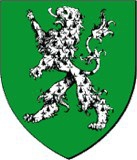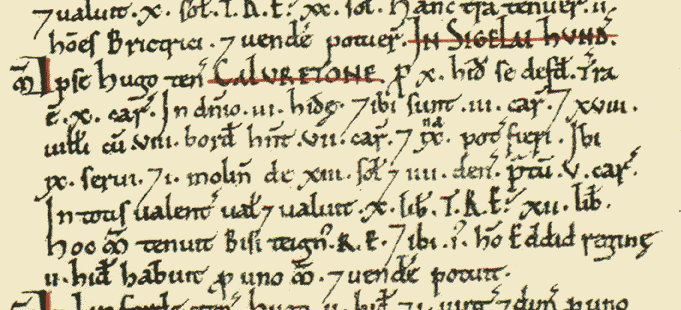Calverton in the Domesday Book
The village of Calverton is mentioned in the Domesday Book, a written record of a statistical survey of England ordered by William the Conqueror. The survey, made in 1086, was an attempt to register all the landed wealth of the country in a systematic fashion. The actual entry for Calverton under the Lordship of Hugh de Bolbec is shown below together with a translation and the Bolbec Coat of Arms:


Translation ; Hugh holds CALVERTON himself. It answers for 10 hides. Land for 10 ploughs; in lordship 3 hides; 3 ploughs there. 18 villagers with 8 smallholders have 7 ploughs; a ninth possible. 9 slaves. 1 mill at 13s 4d; meadow for 5 ploughs. The total value is and was £10; before 1066 £12. Bisi, a thane of King Edward’s, held this manor. There a man of Queen Edith’s had 2 hides as one manor; he could sell.
Hugh de Bolbec accompanied William to England and was well rewarded for his support when William became king, having several other manors as well as the Manor of Calverton bestowed upon him.
Calverton before the Domesday survey
The second paragraph of the entry refers to Calverton in the earlier time of Edward the Confessor when his queen, Queen Edith held the Manor as overlord through one of her Thegnes – a certain Bisi . The manor was noted as being more valuable Edward’s time (£12) and, although it had dropped to being worth £10 by 1086, it remained a significant and desirable holding.



Some terms used in the Domesday Book
The Hide was not an exact measurement of acreage, but in this part of the country is usually taken to be the area that an ox-drawn plough team (of 8 oxen) could cultivate in a year. Reckoning on covering about an acre a day and bearing in mind the time taken for the crop to grow and other ‘down’ times of extreme wet or hard frost when cultivation would not be possible, a hide is thought to be in the region of 120 acres (~49 hectares).
The Virgate is a quarter of a Hide, or some 30 acres (~12 hectares). Considered to be sufficient to support one small farmer and his household.
The Carcurra in classical Latin was a wheeled vehicle or wagon, but by 1086 it had come to mean a heavy plough with two wheels at the front and which was drawn by a team of four pairs of oxen (necessary to overcome the heavy clay soils of this area).

The Villanus was a small farmer who had to get his living from a virgate, or some 30 acres of land (~12 hectares). The word later became the more familiar ‘Villein’.
The Bordarious or smallholder had a small plot of land or garden for domestic use and probably made money by doing other jobs.
The Servus literally meant ‘slave’ – a relic of Anglo-Saxon England. However the Normans did not go in for slavery. The word survives as ‘Serf’.
Money was reckoned in Pounds (Librae), Shillings (Solidi) and Pence (Denarii), hence the £.s.d. of our pre-decimal currency.
Pratum, as in classical Latin, meant a meadow, which could be grazed and/or cut for hay. So, a Pratum for one Carcurra would imply grazing and hay making for eight oxen.
Dominium was the portion of the Manor set aside for the Lord of the Manor’s personal use. Usually the largest and best portion of the land…plus ca change !
Text translation and terms explanation by William Knight 1999